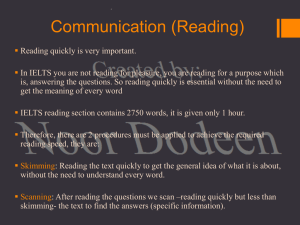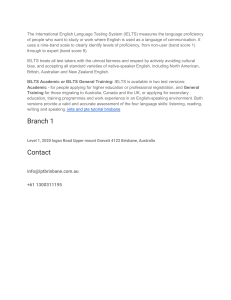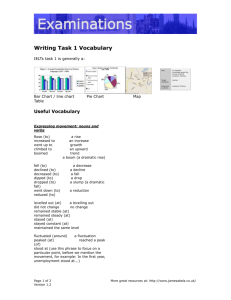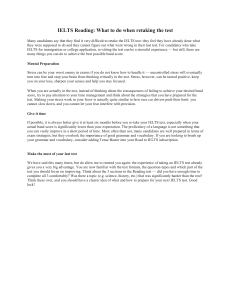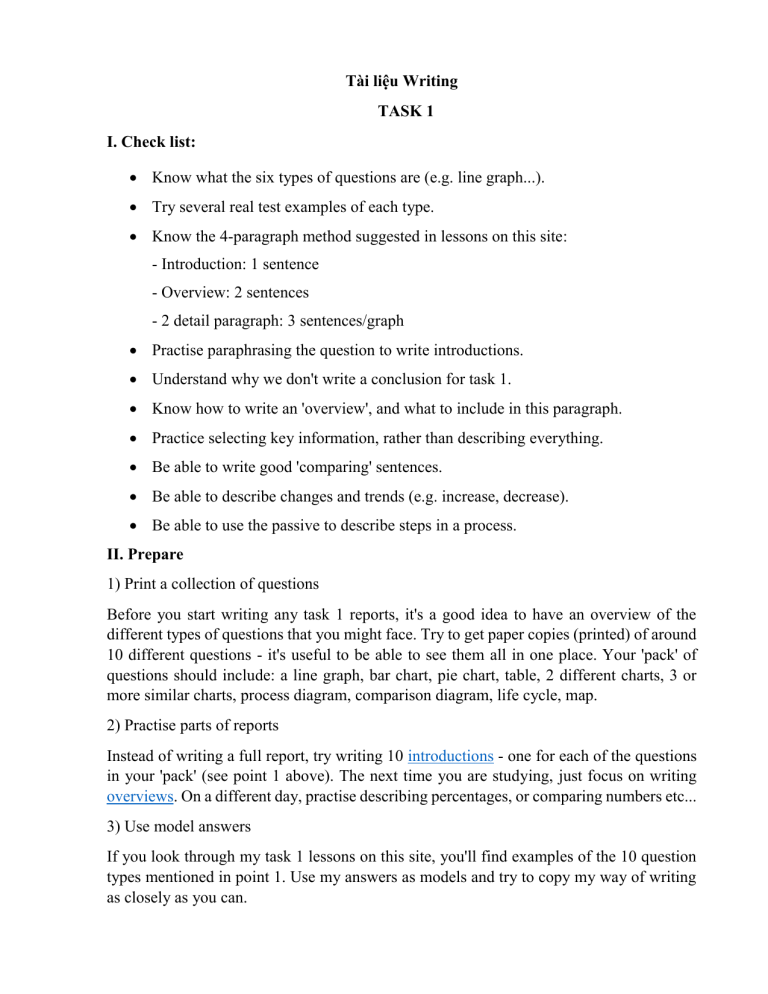
Tài liệu Writing TASK 1 I. Check list: Know what the six types of questions are (e.g. line graph...). Try several real test examples of each type. Know the 4-paragraph method suggested in lessons on this site: - Introduction: 1 sentence - Overview: 2 sentences - 2 detail paragraph: 3 sentences/graph Practise paraphrasing the question to write introductions. Understand why we don't write a conclusion for task 1. Know how to write an 'overview', and what to include in this paragraph. Practice selecting key information, rather than describing everything. Be able to write good 'comparing' sentences. Be able to describe changes and trends (e.g. increase, decrease). Be able to use the passive to describe steps in a process. II. Prepare 1) Print a collection of questions Before you start writing any task 1 reports, it's a good idea to have an overview of the different types of questions that you might face. Try to get paper copies (printed) of around 10 different questions - it's useful to be able to see them all in one place. Your 'pack' of questions should include: a line graph, bar chart, pie chart, table, 2 different charts, 3 or more similar charts, process diagram, comparison diagram, life cycle, map. 2) Practise parts of reports Instead of writing a full report, try writing 10 introductions - one for each of the questions in your 'pack' (see point 1 above). The next time you are studying, just focus on writing overviews. On a different day, practise describing percentages, or comparing numbers etc... 3) Use model answers If you look through my task 1 lessons on this site, you'll find examples of the 10 question types mentioned in point 1. Use my answers as models and try to copy my way of writing as closely as you can. III. How to write overview The overview / summary is a very important part of your task 1 report. Many people have no trouble describing specific details, but they find it difficult to describe the general features of a graph, chart or diagram. So here are my tips on how to write a good overview: 1. Always try to write two sentences. This forces you to describe two main or general features of the graph, chart or diagram. 2. Don't put any numbers in your overview. Save specific numbers for the 'details' paragraphs. 3. If the graph or chart shows a time period (e.g. years), look for the overall change from the beginning to the end of the period (e.g. from the first year to the last year). 4. Look for overall trends, and ignore individual figures that don't fit the trend. For example, if a graph shows a rising trend overall, you can ignore a specific year when the figures decreased - save that year for your 'details' paragraphs. 5. If no time period is shown, you can't look for trends. Instead, look for differences and similarities between items. 6. Don't look for individual 'highest' or 'lowest' figures such as a 'peak' on a line graph. Instead, describe the highest and lowest items overall (e.g. which line on the graph was the highest for the whole or most of the period?). 7. Start your overview with a simple phrase that clearly shows the examiner that this is your summary paragraph e.g. It is clear that... , It is noticeable that... , Overall we can see that... 8. If there are two different charts, write one overview sentence about each chart. 9. If there are more than two charts, they must be connected in some way, so look for two main features overall. 10. If the task is to describe a diagram or map that compares things, you can mention the main differences and maybe the number of differences and / or similarities between the two diagrams. 11. If the task is to describe a process diagram, you can mention the total number of stages in the process and say where or how the process begins and ends. IV. Sample of Writing task 1: Simon IELTS Writing Task 1: 'modes of travel' answer- table chart The table below gives information about changes in modes of travel in England between 1985 and 2000. Average distance in miles travelled per person per year The chart shows average distances that people in England travelled using different forms of transport in the years 1985 and 2000. It is clear that the total number of miles travelled by English people using all modes of transport increased significantly between 1985 and 2000. The car was by far the most used form of transport in both years. In 1985, the average person travelled 3,199 miles by car, and this rose to 4,806 miles in the year 2000. The figures for miles travelled by train, long distance bus, taxi and other modes also increased from 1985 to 2000. Travel by taxi saw the most significant change, with more than a threefold increase from 13 miles per person per year in 1985 to 42 miles in 2000. There was a fall in the average distances for three forms of transport, namely walking, bicycle and local bus. In 1985, English people walked an average of 255 miles, but this figure fell by 18 miles in 2000. Bicycle use fell from 51 to 41 miles over the period shown, while the biggest downward change was in the use of local buses, with average miles per person falling from 429 to 274 over the 15-year period. IELTS Writing Task 1: 'waste graph' answer- line graph The graph below shows the amounts of waste produced by three companies over a period of 15 years. The line graph compares three companies in terms of their waste output between the years 2000 and 2015. It is clear that there were significant changes in the amounts of waste produced by all three companies shown on the graph. While companies A and B saw waste output fall over the 15-year period, the amount of waste produced by company C increased considerably. In 2000, company A produced 12 tonnes of waste, while companies B and C produced around 8 tonnes and 4 tonnes of waste material respectively. Over the following 5 years, the waste output of companies B and C rose by around 2 tonnes, but the figure for company A fell by approximately 1 tonne. From 2005 to 2015, company A cut waste production by roughly 3 tonnes, and company B reduced its waste by around 7 tonnes. By contrast, company C saw an increase in waste production of approximately 4 tonnes over the same 10-year period. By 2015, company C’s waste output had risen to 10 tonnes, while the respective amounts of waste from companies A and B had dropped to 8 tonnes and only 3 tonnes. IELTS Writing Task 1: two-chart answer- bar chart and table The chart below shows the value of one country's exports in various categories during 2015 and 2016. The table shows the percentage change in each category or exports in 2016 compared with 2015. The bar chart and table give information about a country's export earnings from five groups of products in 2015 and 2016. It is noticeable that export revenues in all but one of the five product categories increased over the period shown. While petroleum products were the highest earning exports in both years, the textile industry saw the most significant growth in earnings. Export earnings from petroleum products rose from around $61 billion in 2015 to $63 billion in 2016, which was an increase of 3%. Income from engineered goods reached a similar level. The country’s export earnings from these goods went up by 8.5% to approximately $62 billion in 2016. From 2015 to 2016, there was a 15.24% increase in export revenue from textiles, with earnings rising from roughly $25 billion to over $30 billion. By contrast, there was almost no change in the amount of money earned from agricultural products, which remained at just over $30 billion. Finally, the only decline in income occurred in the gems and jewellery product group, where export earnings fell by around 5% to approximately $40 billion in 2016. IELTS Writing Task 1: 'fish pie' process diagram answer The diagrams below give information about the manufacture of frozen fish pies. The pictures illustrate the ingredients that go into a factory-made fish pie, and the various steps in its production. The pie contains salmon, peas, sauce and potatoes, and there are ten stages in its manufacture, from delivery to dispatch. One of the ingredients, potato, goes through its own six-stage preparation process before it can be added to the pie. Potatoes are the first ingredient to be prepared on the production line. They are delivered to the factory up to a month before the process begins, and they must be cleaned, peeled and sliced. Potato peelings are thrown away, and the sliced potatoes are boiled, then chilled and stored. When fresh salmon arrives at the factory, lemon juice and salt are added, and the fish is cooked in a steam oven within 12 hours of delivery. Next, factory workers remove and dispose of the skin and bones, and the fish is inspected. Following inspection, pre-prepared peas, sauce and potatoes are added. The resulting fish pies are wrapped, frozen and then stored or dispatched. IELTS Writing Task 1: 'maps' answer The two maps below show road access to a city hospital in 2007 and in 2010 The maps illustrate some changes that were made to a city hospital's transport infrastructure between the years 2007 and 2010. It is noticeable that three main modifications were made to the hospital’s vehicle access. These involved the building of a new bus station, new roundabouts and new parking facilities. Looking at the changes in more detail, we can see that in 2007 there were three bus stops on either side of Hospital Road. These were no longer present in 2010, and instead we see the addition of a bus station on the west side of Hospital Road. This bus station is accessed via two new roundabouts; the first roundabout is at the intersection of City Road and Hospital Road, while the second is at the other end of Hospital Road, at the junction with the hospital ring road. The two maps also show that changes were made to public and staff parking areas. In 2007, staff and visitors used the same car park, which was situated to the east of Hospital Road and accessed via the ring road. However, by 2010 this original car park had become a designated area for staff parking only. A new car park, located on the east side of the ring road, provided parking for members of the public. IELTS Writing Task 1: 'languages charts' answer – pie chart The charts below show the proportions of British students at one university in England who were able to speak other languages in addition to English, in 2000 and 2010. The tables compare the percentages of British university students who spoke different languages in addition to English in two separate years. It is noticeable that in both years, 2000 and 2010, the majority of British students at the university in question were able to speak at least one other language. We can also see an increase in the proportion of second and third language speakers over the 10-year period. In the year 2000, 80% of the students were able to speak one or two foreign languages, and 20% only spoke English. Ten years later, there was a rise of 5% in the proportion of those who spoke a second language. There was also an increase, from 10% to 15%, in the proportion of students who were able to speak two foreign languages. Looking at the specific second languages spoken, in 2000, 30% of the students were able to speak Spanish, 15% spoke French, and 10% spoke German. By 2010, the proportion of Spanish speakers had risen to 35%, there were 5% fewer French speakers, and the figure for German speakers remained at one in ten. Finally, we can see that the percentage of speakers of other second languages, apart from Spanish, French and German, rose from 15% to 20% over the period shown. IELTS Writing Task 1: 'physical activity' answer – Bar chart The bar chart below shows the percentage of Australian men and women in different age groups who did regular physical activity in 2010. Summarise the information by selecting and reporting the main features and make comparisons where relevant. The chart compares the proportions of Australian males and females in six age categories who were physically active on a regular basis in the year 2010. Roughly speaking, close to half of Australian adults did some kind of routine physical activity in 2010. Middle aged females were the most physically active, proportionally, while males aged 35 to 44 did the least physical activity. In the youngest age category (15 to 24), almost 53% of Australian men but only 47.7% of women did regular physical activity in 2010. However, between the ages of 25 and 44, men were much less active on average than women. In fact, in the 35 to 44 age group, a mere 39.5% of males did some form of regular exercise, compared to 52.5% of females. Between the ages of 45 and 64, the figure for male physical activity rose to around 45%, while the proportion of active females remained around 8% higher, at 53%. Finally, the percentages of Australian women and men aged 65 and over who exercised regularly were almost identical, at approximately 47%. IELTS Writing Task 1: process diagram answer The diagrams below show the stages and equipment used in the cement-making process, and how cement is used to produce concrete for building purposes. The first diagram illustrates the process of cement manufacture, and the second diagram shows the materials that go into the production of concrete. It is clear that there are five stages in the production of cement, beginning with the input of raw materials and ending with bags of the finished product. To produce concrete, four different materials are mixed together. At the first stage in the production of cement, limestone and clay are crushed to form a powder. This powder is then mixed before it passes into a rotating heater. After heating, the resulting mixture is ground, and cement is produced. Finally, the cement is packaged in large bags. Cement is one of the four raw materials that are used in the production of concrete, along with gravel, sand and water. To be exact, concrete consists of 50% gravel, 25% sand, 15% cement and 10% water. All four materials are blended together in a rotating machine called a concrete mixer. IELTS Writing Task 1: 'fast food' answer The chart below shows how frequently people in the USA ate in fast food restaurants between 2003 and 2013. The bar chart illustrates the frequency with which Americans ate in fast food establishments from 2003 to 2013. It is clear that the majority of Americans ate in fast food restaurants between once a week and once a month in all three years. We can also see a shift towards eating in these restaurants less frequently by the end of the 10-year period. In each of the years shown on the chart, close to 60% of people in the US ate in fast food restaurants between once and four times a month. Roughly 15 to 20% of Americans reported eating in fast food outlets several times per week, while 3 to 4% of people ate in these outlets daily. At the other end of the scale, around 4% of people avoided fast food restaurants completely. Between 2006 and 2013, the total proportion of Americans who ate in fast food establishments either once a week or several times a week fell by by almost 10%. At the same time, there was an increase of around 8% in the ‘once or twice a month’ category. In other words, the weekly fast-food habit that was common in 2003 and 2006 became a monthly or twice monthly habit in 2013. IELTS Writing Task 1: band 9 map answer The maps below show the centre of a small town called Islip as it is now and plans for its development. The diagrams illustrate some proposed changes to the central area of the town of Islip. It is clear that the principal change to the town will be the construction of a ring road around the centre. Various other developments with regard to shops and housing will accompany the building of this road. Looking at the map of Islip as it is now, we can see that a main road runs through its centre from east to west. The second map shows the planned pedestrianisation of this road. Traffic will be diverted on to a dual carriageway that will form a ring around the town centre. Currently there is a row of shops along either side of the main road. However, it appears that the shops along the north side of the new pedestrian street will be demolished to make way for a bus station, shopping centre, car park and new housing area. The shops along the south side of the street will remain, but it seems that the town’s park will be reduced in size so that more new houses can be built within the ring road. IELTS Writing Task 1: 'hospital attendances' bar chart The chart below shows figures for attendances at hospital emergency care departments in Northern Ireland by age group in December 2016 and December 2017. Attendances at emergency care departments per 1000-population The bar chart compares the number of visits made by people in six age categories to hospital emergency wards in Northern Ireland in the December of 2016 and 2017. It is clear that elderly people and the youngest children were the most frequent visitors to A&E (accident and emergency) departments. Also, there was a slight increase in the rate of emergency care attendances among all six age groups from December 2016 to December 2017. Looking first at the older age groups, roughly 65 people, per 1000 population, aged 75 and over attended A&E wards in December 2016, and this rose to almost 70 attendances per 1000-population one year later. Interestingly, those aged 65 to 74 were less than half as likely to require emergency treatment, with around 30 attendances per 1000-population in both months. At the other end of the age scale, the figures for A&E visits by under-5s rose marginally from around 50 to approximately 52 per 1000-population over the one-year period. Children aged 5 to 15 made the fewest visits, at just over 20 per 1000-population in both months. Finally, there was almost no difference in the figures for emergency care attendances among people aged 16 to 44, 45 to 64 and 65 to 74. IELTS Writing Task 1: only 6 sentences!- line graph The graph below shows the average daily spend of three categories of international visitor to New Zealand from 1997 to 2017. The line graph compares three types of traveller to New Zealand between 1997 and 2017 in terms of their average daily expenditure. It is noticeable that spending by these international visitors was at its highest between the years 2000 and 2003. Overall, business travellers spent the most per day, while people visiting friends or relatives spent the least. In 1997, business visitors to New Zealand spent an average of almost $260 per day, while holidaymakers spent around $190 and people visiting friends or relatives spent less than $120. Over the following five years, spending by all three types of traveller increased dramatically, to peaks of around $330, $270 and $220. However, visitor spending suddenly fell again between 2003 and 2005. From 2005 to 2015, the daily expenditure of business travellers and tourists fluctuated around the $200 mark, whereas people visiting relations or friends spent roughly 60 to 80 dollars less per day. By 2017, daily spending had risen to approximately $250, $210 and $140 respectively for vacationers, business people and those visiting loved ones. IELTS Writing Task 1: silkworm life cycle answer The diagrams illustrate the stages in the life of a silkworm and the process of producing silk cloth. There are four main stages in the life cycle of the silkworm, from eggs to adult moth. The process of silk cloth production involves six steps, from silkworm cocoon to silk material. At the first stage in the life cycle of a silkworm, the moth lays its eggs. Around ten days later, silkworm larvae hatch from the eggs; these larvae feed on mulberry leaves. Then, after four to six weeks, the larvae become covered in silk thread, and it takes between three and eight days for a full cocoon to be produced. For silk cloth production, a cocoon is first selected and then boiled in water. After boiling, the silk thread that makes up the cocoon is unwound, and then several strands of thread are twisted together. At the fifth and sixth stages in the process, the thread can either be dyed and then woven into silk fabric, or it can be woven first and then dyed subsequently. IELTS Writing Task 1: two charts answer The charts below show reasons for travel and the main issues for the travelling public in the US in 2009. The bar chart and pie chart give information about why US residents travelled and what travel problems they experienced in the year 2009. It is clear that the principal reason why Americans travelled in 2009 was to commute to and from work. In the same year, the primary concern of Americans, with regard to the trips they made, was the cost of travelling. Looking more closely at the bar chart, we can see that 49% of the trips made by Americans in 2009 were for the purpose of commuting. By contrast, only 6% of trips were visits to friends or relatives, and one in ten trips were for social or recreation reasons. Shopping was cited as the reason for 16% of all travel, while unspecific ‘personal reasons’ accounted for the remaining 19%. According to the pie chart, price was the key consideration for 36% of American travellers. Almost one in five people cited safety as their foremost travel concern, while aggressive driving and highway congestion were the main issues for 17% and 14% of the travelling public. Finally, a total of 14% of those surveyed thought that access to public transport or space for pedestrians were the most important travel issues. IELTS Writing Task 1: 'educational problems' table The table below gives information about the problems faced by children in two primary schools in 2005 and 2015. The table compares two primary schools in terms of the proportions of their pupils who experienced seven different educational problems in the years 2005 and 2015. It is noticeable that school A had higher proportions of children with all seven educational difficulties in both years. However, while school A managed to reduce the incidence of most of the problems between 2005 and 2015, school B saw an overall rise in the percentage of children who were struggling. In 2005, 42% of school A’s pupils found it difficult to follow instructions, whereas only 6% of pupils in school B experienced this problem. Similarly, between 30 and 40 per cent of children attending school A had problems in the areas of spelling, listening, verbal expression and concentration in lessons, while the equivalent figures for school B stood at between 5 and 15 per cent. In 2015, the difference between the two schools was less pronounced. Notably, the proportion of children who struggled to follow instructions fell by 24% in school A, and this school also saw falls of 22%, 15%, 14% and 5% in the figures for children who had problems with concentration, listening, verbal expression and spelling. In school B, however, the proportion of children who struggled with spelling and following instructions doubled, to 10% and 12% respectively, and there was almost no change in the incidence of listening, verbal or concentration problems. IELTS Writing Task 1: pie chart answer The chart below shows the results of a survey of people who visited four types of tourist attraction in Britain in the year 1999. The pie chart compares figures for visitors to four categories of tourist attraction and to five different theme parks in Britain in 1999. It is clear that theme parks and museums / galleries were the two most popular types of tourist attraction in that year. Blackpool Pleasure Beach received by far the highest proportion of visitors in the theme park sector. Looking at the information in more detail, we can see that 38% of the surveyed visitors went to a theme park, and 37% of them went to a museumy or gallery. By contrast, historic houses and monuments were visited by only 16% of the sample, while wildlife parks and zoos were the least popular of the four types of tourist attraction, with only 9% of visitors. In the theme park sector, almost half of the people surveyed (47%) had been to Blackpool Pleasure Beach. Alton Towers was the second most popular amusement park, with 17% of the sample, followed by Pleasureland in Southport, with 16%. Finally, Chessington World of Adventures and Legoland Windsor had each welcomed 10% of the surveyed visitors. IELTS Writing Task 1: separate line graphs answer The first chart below gives information about the money spent by British parents on their children’s sports between 2008 and 2014. The second chart shows the number of children who participated in three sports in Britain over the same time period. The line graphs show the average monthly amount that parents in Britain spent on their children’s sporting activities and the number of British children who took part in three different sports from 2008 to 2014. It is clear that parents spent more money each year on their children’s participation in sports over the six-year period. In terms of the number of children taking part, football was significantly more popular than athletics and swimming. In 2008, British parents spent an average of around £20 per month on their children’s sporting activities. Parents’ spending on children’s sports increased gradually over the following six years, and by 2014 the average monthly amount had risen to just over £30. Looking at participation numbers, in 2008 approximately 8 million British children played football, while only 2 million children were enrolled in swimming clubs and less than 1 million practised athletics. The figures for football participation remained relatively stable over the following 6 years. By contrast, participation in swimming almost doubled, to nearly 4 million children, and there was a near fivefold increase in the number of children doing athletics. IELTS Writing Task 1: 'living alone' charts The bar chart below shows the proportions of English men and women of different ages who were living alone in 2011. The pie chart compares the numbers of bedrooms in these one-person households. The two charts give information about single-occupant households in England in the year 2011. The bar chart compares figures for occupants' age and gender, and the pie chart shows data about the number of bedrooms in these homes. Overall, females made up a higher proportion of people living alone than males, and this difference is particularly noticeable in the older age categories. We can also see that the most common number of bedrooms in a single-occupant home was two. A significant majority of the people aged 65 or over who were living alone in England in 2011 were female. Women made up around 72% of single occupants aged 75 to 84, and 76% of those aged 85 or over. By contrast, among younger adults the figures for males were higher. For example, in the 35-49 age category, men accounted for nearly 65% of people living alone. In the same year, 35.4% of one-person households in England had two bedrooms, while one-bedroom and three-bedroom homes accounted for 28% and 29.8% of the total. Under 7% of single-occupant homes had four or more bedrooms. IELTS Writing Task 1: stacked bar chart essay The chart below shows the total number of Olympic medals won by twelve different countries. The bar chart compares twelve countries in terms of the overall number of medals that they have won at the Olympic Games. It is clear that the USA is by far the most successful Olympic medal winning nation. It is also noticeable that the figures for gold, silver and bronze medals won by any particular country tend to be fairly similar. The USA has won a total of around 2,300 Olympic medals, including approximately 900 gold medals, 750 silver and 650 bronze. In second place on the all-time medals chart is the Soviet Union, with just over 1,000 medals. Again, the number of gold medals won by this country is slightly higher than the number of silver or bronze medals. Only four other countries - the UK, France, Germany and Italy - have won more than 500 Olympic medals, all with similar proportions of each medal colour. Apart from the USA and the Soviet Union, China is the only other country with a noticeably higher proportion of gold medals (about 200) compared to silver and bronze (about 100 each). IELTS Writing Task 1: Brick manufacturing The fugures illustrate the stages in the process of producing clay bricks for the building industry. Overall, the key point to note is that is that the process of brick production involves seven steps, from digging the clay from the ground to delivery of the finished bricks to customers. At the beginning of the process, clay is dug from the ground. The clay is put through a metal grid, and it passes onto a roller where it is mixed with sand and water. After that, the clay can be shaped into bricks in two ways: either it is put in a mould, or a wire cutter is used. At the fourth stage in the process, the clay bricks are placed in a drying oven for one to two days. Next, the bricks are heated in a kiln at a moderate temperature (200 - 900 degrees Celsius) and then at a high temperature (up to 1300 degrees), before spending two to three days in a cooling chamber. Finally, the finished bricks are packaged and delivered. IELTS Writing Task 1: 'flood diagram' answer The diagrams below show how houses can be protected in areas which are prone to flooding. The diagrams compare two different methods of defence for homes which are at risk of being flooded. The key difference between the diagrams is that they show flood protection with and without a stopbank. In either case, the at-risk home is raised on stilts above ground level. The first diagram shows how a stopbank acts as a flood barrier to stop river water from flooding homes. The stopbank is a small mound of land next to the river that is higher than the 100-year flood level, and prevents the river from bursting its banks. Nearby houses can be built on stilts to prevent flooding from rainwater, and a floodgate beneath the stopbank can be opened to allow this ‘ponding’ to drain off into the river. When there is no stopbank, as shown in the second diagram, there will be nothing to stop the river from flooding. In this case, the solution is to put buildings on stilts. The height of the stilts is measured so that the floor of the house is 300mm above the 100-year flood level. This measurement is called the ‘freeboard’. IELTS Writing Task 1: 'flood diagram' answer The diagram below shows the life cycle of a salmon, from egg to adult fish. The diagram illustrates the stages in the life of the salmon, from birth to maturity. It is clear that there are six* main stages as the salmon develops from egg to mature adult. We can also see that salmon spend time in three distinct locations during the cycle, moving from river to estuary to ocean and then back upstream. Salmon begin their lives in rivers where the adult fish lay and incubate their eggs. After emerging from eggs, the young salmon spend the next stage of their lives being reared in freshwater areas. Then, at some point in their development, the fish swim downstream to river estuaries where rearing continues. Following the estuary rearing period, the maturing salmon migrate to the ocean, where they eventually become fully grown adults. Finally, the adult fish travel back upstream to spawning areas of rivers; here they reproduce and lay their eggs, and the life cycle begins anew.
